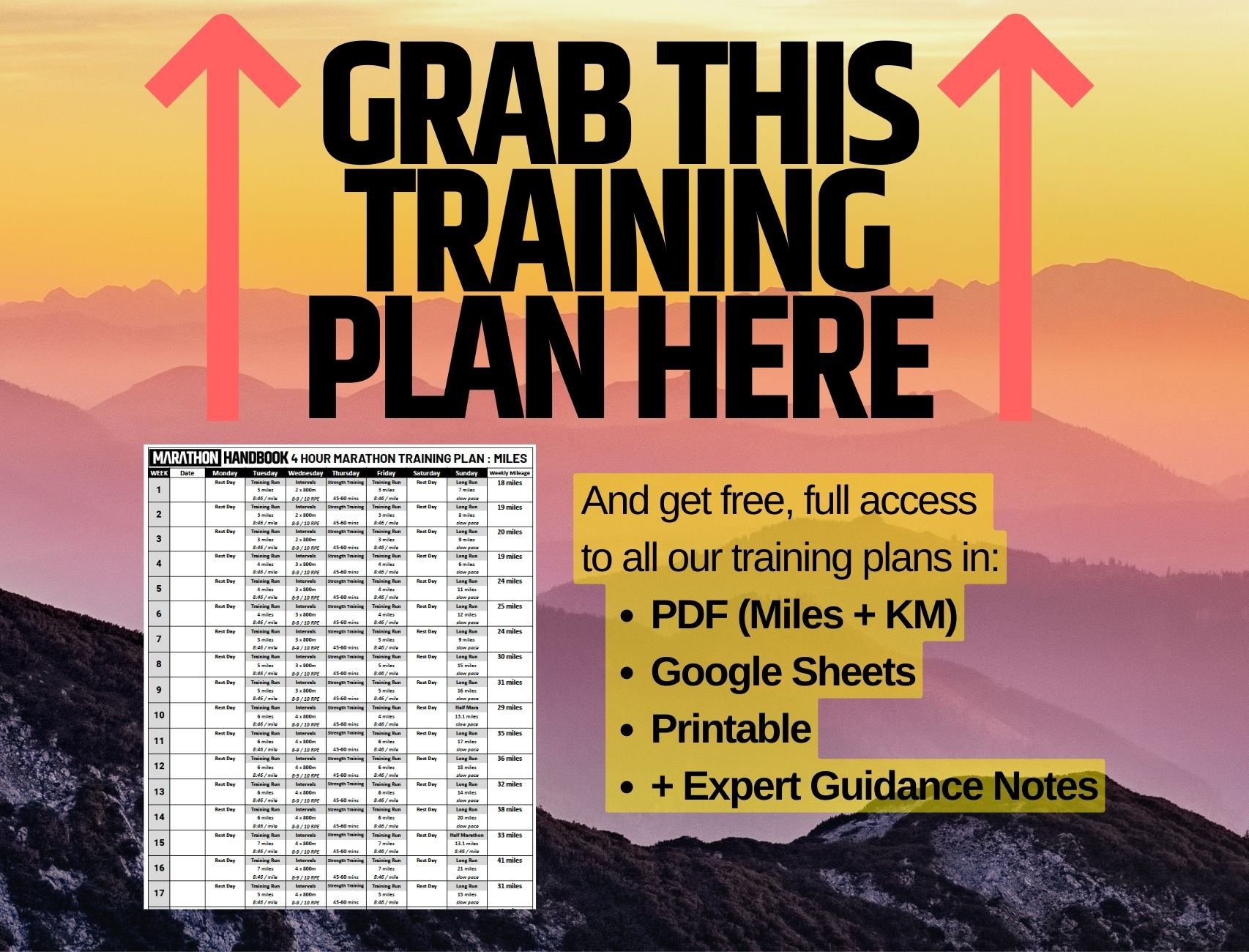Whether you’ve been at the running game for a while now or would be considered a relative newbie to the sport, running your first half marathon race has probably crossed your mind.
The half marathon is a popular race distance, and many runners see it as the natural stepping stone in their quest to complete the full marathon distance.
If you have a certain level of training under your belt and a good fitness base, the target of running a sub 90 minute half marathon is an achievable goal.
A sub 90 minute half marathon is considered above average. It would require the runner to have a good base in aerobic endurance and some experience of racing shorter distances such as 10km or 5km races.
According to Running Level, the average time for a half marathon is 1:50:15, so having a goal of going for a sub 90 minute half marathon would put you in the intermediate to advanced level of running.
This challenge of running a sub 90 minute half marathon may seem like quite a challenging undertaking– daunting even.
However, with a determined approach and consistent training, it can be done!
Let’s take a closer look at my top tips below. I’ll keep it simple and structured so you don’t find yourself getting tangled up metaphorically speaking.
In this article, I’ll walk you through:
- The importance of getting your pace right
- Why you should include tempo running in your sub 90 minute half marathon training
- The long run
- Training guide + training plan for a sub 90 minute half marathon
- How best to prepare for race day – taper and race day routines
Ready? Let’s jump in!
Not sure this is the plan for you? – Check out our other half-marathon training plans.

I remember the first time I broke the barrier. I had entered the inaugural Dublin Rock & Roll half marathon in 2013, and I set myself the target of running a sub 90 minute half marathon.
I started as controlled as I could and settled into a group tracking the relevant pacemaker. One memory stands out, and it was just after the 10-mile point, where we had been greeted by a band playing the Boys are Back in Town.
Shortly afterward, as we left Phoenix Park, we took a sharp corner, and somehow the pacemaker managed to get himself tangled up around a lamppost with his pacing balloon. However, he quickly released himself and helped us bring it home in 1.29.13.
#1: Pacing is key – interval training sessions
If you want to run a half marathon in 90 minutes, your body needs to get comfortable running at an average pace of 4 minutes 15 seconds/km or 6.50 per mile.
However, come race day we recommend you run a little bit faster than this, in order to give yourself approximately 5 minutes of extra time to account for any toilet stops, unexpected hills, or other unanticipated delays!
One of the keys to achieving your goal is knowing your average pace and sticking to it. It is very easy to get caught up in the hype at the start of the race, and you may end up running too fast.
There’s evidence that runners who can hold a consistent pace throughout the race, or even hit negative splits, tend to get closer to their target race time goal (and cross the finish line feeling GOOD).
This is called even splits – meaning that when you look back at each section of your race (say every 5k), it would have taken you roughly the same time for each.
You can make use of our Half Marathon Pace Calculator to get a downloadable chart of the even splits for a sub-90 minute half marathon – just enter 1:25:00 rather than 1:30:00 as the time in order to give yourself a little bit of headroom come race day.

We recommend you try running some interval reps, speed work, or a fartlek at your target pace. For instance, a session of 6 x 2k at the target pace with a 90-second recovery will help you get more accustomed to the required pace to run a sub 90 minute half marathon.
In addition, using interval training and speed work quicker than your target race pace will assist you. Building into your plan some intervals at 10km and 5km pace will help you feel more comfortable at the target half marathon pace.
Start with intervals at your 10k pace – 4 minutes 5 seconds/km (6 minutes 16 seconds/mile).
A good initial session is to run miler repeats, beginning with four repetitions of a mile with a 2-minute recovery between each one. You can try longer intervals such as 2k at the same pace with a 2-minute recovery as you get stronger.
Then, the next stage would be to run intervals at a target 5k pace of 3 minutes 55 seconds/km (6 minutes 32 seconds/mile). You should aim to run 10-12 of 600m with a 90-second recovery.
Then, you can increase the distance of the interval to 800m and then 1000m as your fitness improves. Aim to run a maximum of 8 repetitions of 800m and 5 of 1000m with the same recovery.
Since you’ll be working hard and getting your heart rate up, make sure with each interval session, you incorporate a good warm up and cool down.

#2: Tempo running
A tempo run is an example of a high-quality workout for runners and is an essential part of the weekly training plan. The Kenyans consider it one of their critical sessions!
Tempo runs have many benefits and primarily help build your lactate threshold (LT), critical for running faster. Your LT is the point at which lactic begins to accumulate in muscles.
The increase in lactate threshold from regular tempo runs is significant for people preparing for half-marathons. The pace you can sustain for long distances will be faster before the build-up of lactic acid sets in.
The duration of the run is generally between 5km and 8km or between 20 minutes and 40 minutes.
It is described as a “comfortably uncomfortable pace.” You certainly wouldn´t be able to hold a conversation running at this pace, but you also don´t want to feel overly tired after it either.
Finding the right pace to run your tempo sessions at will require a little bit of experimenting. A general rule of thumb is to run at a pace that you could sustain for an hour.
This is usually considered to be between your 10km and half marathon pace, but closer to the latter.
So, if your goal pace for your sub 90 minute half marathon is 4 minutes 15 seconds per km and your estimated 10k pace of 4 minutes 5 seconds, you should aim to run your tempo runs around 4 minutes 12 seconds.

#3: Hills
Improving your leg strength will help you develop the speed needed to run a sub 90 minute half marathon. Hill running and circuits are two of the most effective ways of doing this.
There are several different sessions that you can do. First, find a hill that measures 100m with a moderate gradient. Run a series of 6-10 hills, with a jog back recovery.
Remember to keep good running form and don´t get too caught up in racing to the top!
Alternatively, you can find a steeper hill to work on power. Run for 15 seconds as fast as possible and then walk back down to fully recover before repeating three more times.
Strength training is another effective way to build specific leg strength. It can help increase your stride length, leading to greater sprinting speed.
Some key exercises include squats, lunges, burpees, squat-thrusts, one-legged squats, and calf raises. Complete 15-20 repetitions of each exercise and do two complete circuits.

#4: Long run
Most runners will be familiar with a long-run concept, and it should be part of any runner’s half marathon schedule.
This easy-paced run of between 10km-16km or 60 mins- to 90 mins will improve your endurance and give you a chance to recover from the hard sessions earlier in the week.
It is exactly how it sounds – a run that lasts longer than the rest of your weekly runs and is typically performed at a steady, easy pace.
One common misconception is that to run the half marathon well, you should be doing all your long runs at the target pace.
However, this would leave your body fatigued, and you may break down and pick up an injury caused by the constant stress you are placing on your body.
Run your long runs at a relaxed, easy pace.
The aim is to enhance your body´s ability to burn fat and, at the same time, save up your limited muscle glycogen stores, as well as improve your leg strength and resistance to fatigue.

5. Bringing it all together
I’d recommend you test out each of the sessions described and then, after a few weeks, decide on the right balance for you.
Some people can train six days a week with one rest day; others can only allocate 3 or 4 days to their sub 90 minute half marathon training.
I’d recommend you stick to what you can do consistently and something that doesn’t put too much stress on your body and results in injuries.
If you’re looking for something more specific, below, I have set out an 8-week training plan for those who can commit to running five days a week with one active recovery day or very easy run.
It’s best to group a tempo with an interval session one week and then with a hill session the following week.
This will give your body ample time to recover. Continue to use your long run to build endurance and recover from the hard days. Allow your body to adapt to this extra load.
I’ve included a period of taper where you will reduce your running to feel fresh and rested on race day.
According to Kyle Doherty (from 79.40 minutes to 67.49 in 8 years): “When it comes to tapering for the half marathon, I would normally run right up until ten days out as normal doing a workout eight days out that’s going to show me what kind of shape I’m in. I’d start to taper then and cut mileage to around 50/60%. “
Download The 8 week 1:30 Half Marathon Training Plan:

Download The Training Plan Here
Enter your email, and I’ll send you this free training plan now, in PDF and Google Sheets formats (completely customizable), in both miles and kilometers.
After entering your email, you’ll be prompted to create an account on the Grow platform we use to control access to the plans. It’s completely free – make sure to complete the process to gain access to the plan!
Previous visitor or not seeing where to sign up?
Head over to our half marathon training plan database for full access to all plans.


- Target pace workout is running long intervals at your half marathon pace
- Long runs should be done at a slow, conversational pace
- Don´t skip your rest days – they are critical for allowing your body to absorb the training adaptations
- If you are finding it difficult to do both days of interval training, change for a recovery run instead
- Week 4 is a down week where you´ll only have one tempo session

#6: Race day approaches
So, you’ve been consistent with your training over the past eight weeks, from your easy days, speed work, intervals, and fartlek runs.
You are ready to run your sub 90 minute half marathon!
The best advice on race day is not to try anything new. Get up, have the same breakfast you usually do and arrive at the race venue with enough time to warm up with 20 minutes of light jogging followed by 4-5 strides to get the body ready.
Kyle Doherty recommends the following:
“Same breakfast, drinks, bed at the usual time, change nothing, so it gives me the same feeling like any other day with a workout in the morning. Breakfast 3 hours before and carb snack 90 mins. Plenty of moving around in the 90 mins leading up to race start and chatting to friends or listening to music, so the race itself isn’t on my mind.”
Trust in the training that you have done. Relax and settle into your own rhythm, and target race pace of 4 minutes 15 seconds/km. Remind yourself that the feeling of discomfort is something you have felt before in training sessions, and your body can endure it.
Let’s get training!
If you aren’t quite ready to train for a sub 90 minute half marathon but are looking for a shorter race, check out our 5k and 10k training programs.

Other Suggested Half Marathon Training Plans:
Beginner + Novice Training Plans
- Couch To Half Marathon Training Plan
- 5k To Half Marathon Training Plan
- Beginner 16 Week Half Marathon Training Plan
- 15 Week Beginner Half Marathon Training Plan
- 12 Week Half Marathon Training Plan
Intermediate + Advanced Half Marathon Training Plans
- 10k To Half Marathon Training Plan
- 10 Week Improver Half Marathon Training Plan
- 8 Week Half Marathon Training Plan
- 6 Week Half Marathon Training Plan
- 4 Week Half Marathon Training Plan
Time-based Half Marathon Training Plans
- Sub 2-Hour Half Marathon Training Plan
- 1:45 Half Marathon Training Plan
- 1:30 Half Marathon Training Plan – 12 Weeks
- 1:30 Half Marathon Training Plan – 8 Weeks
Check out the Half Marathon Training Plans page for more and GOOD LUCK!














Interesting, I look forward to taking this schedule to my next 1/2 marathon!
if have used this trainingplan last year and i managed to get a 1:28 half marathon!